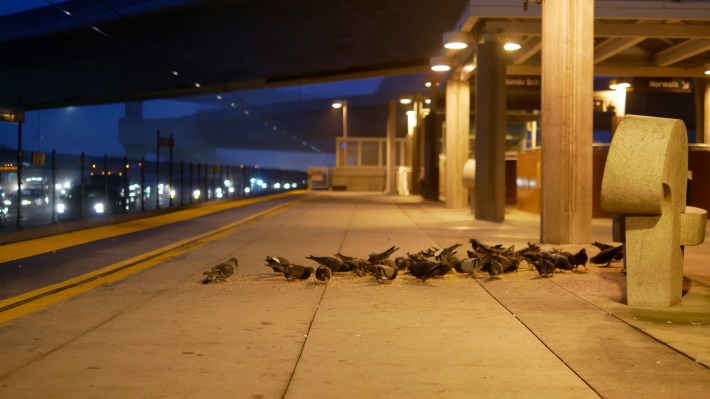The 110-105 interchange holds a unique place in the psyche of Los Angeles. I’ve always called it The Cathedral, because it feels like you’re inside one when you’re driving under the towering, chapel-like crests of the ramps connecting the highways. The sounds of speeding engines in trucks and cars amplify against the network of massive concrete pillars sustaining the bridges, so it almost sounds like voices singing from a hymnal.
At all levels the thing is intense. Driving overhead, it almost feels like you’re about to fly through the sky into the downtown skyline when you’re changing from the 105 West to the 110 North. And way underneath, at traffic-lane level, for commuters using the Metro bus and rail transit hub to get around, the setting is stark: extreme noise, exposure to harmful exhaust, and views of encampments in the concrete shadows.
But there are also wondrous aspects to the interchange. Its history is an epic read shaped by a protagonist federal judge named Harry Pregerson, who eventually redefined the process of bringing a massive government works project to an economically depressed and dense urban area, like the South Figueroa Street corridor was in the 1970s. The interchange had starring roles in 1994’s Speed (when the bus leaps over a gap in an unfinished overpass) and last year’s La La Land (the big opening dance number). And for photographer Lindsey Mysse, who began to regularly use the 110-105 transit station on a commute, the interchange offered a window into a side of Los Angeles he never thought he’d get to know.
Mysse is an artist and software developer by day, and in his free-time a devoted documentarian of the interchange with the IG account 110_105. In it Mysse captures the light, colors, and faces he sees in the soaring chapel of the interchange.
I spoke to him recently over the phone about the project. Below is a sample of some of his photos.

L.A. TACO: Tell us how the project got started.
Mysse: The specific Instagram account started earlier this year. … Well, really what happened was that I had just come back from New York City, had been dumped by a girl, and my art career had kinda fallen apart. Everyone was pissed at me, and I just needed to get a real job.
I live in San Pedro and I got a job in El Segundo, so I started commuting from San Pedro to El Segundo — the bus, from San Pedro, to get on the Green Line to get to El Segundo — and it was just this ugly, ugly place to me. It represented a defeat in life. It felt like the world was making fun of me. It actually started as a joke. I’d check-in at the 105-110 freeway, and start taking photos of it …

What is this place like, for someone who hasn’t been to the transit station?
It’s very loud, it’s very dirty, because the cars: there’s just chain-link fence between you and the highway. But you also kinda have the people there, they’re just getting to their jobs, there’s that sort of day-to-day negotiation of, How you get around, right?
Last week the trains broke down — it’s the Green Line, the trains are always breaking down — people were negotiating, like, My boss is stricter than your boss, and so on, negotiating who could get on the train because the trains were packed. And it’s democracy in action. That’s how the city works.

It’s one of the most hostile places in L.A. to humans, isn’t it?
I think so. People live there, though, under the 110 and 105. I don’t photograph them, so they tend not to be in my photographs, but yeah, there are people that live there. You see the encampments, how they hide themselves, and it really is shocking. A lot of people drive and just stare straight ahead, and there’s this whole world along the edges.
I take photographs every time I am there ... four to six times a week.

What did you end up liking about it?
It’s banality at a grand scale, which is what Los Angeles is all about. If that place is beautiful to you or not is determined by how you feel. It’s your projection on the place, which is very L.A., too. … It’s this blank canvas, and it’s a massive artifact to a way of life that isn’t very sustainable also.
The freeways. You learn so much about the city when you really study them, right?
You find that everywhere in L.A. but most people just filter it out. With something like 110-105, people just drive by and you don’t really contemplate it, what it is or what it means.

What did you learn about this place over time?
I started to pay attention to how the light would change everyday I was there. The colors would always be different. As you go through the year, you get there at different times of dawn or sunset, you get those Southern California sunrises and sunsets and all the colors and how they reflect off the concrete. It really becomes something intriguing to follow.



Follow @110_105 to see more.







